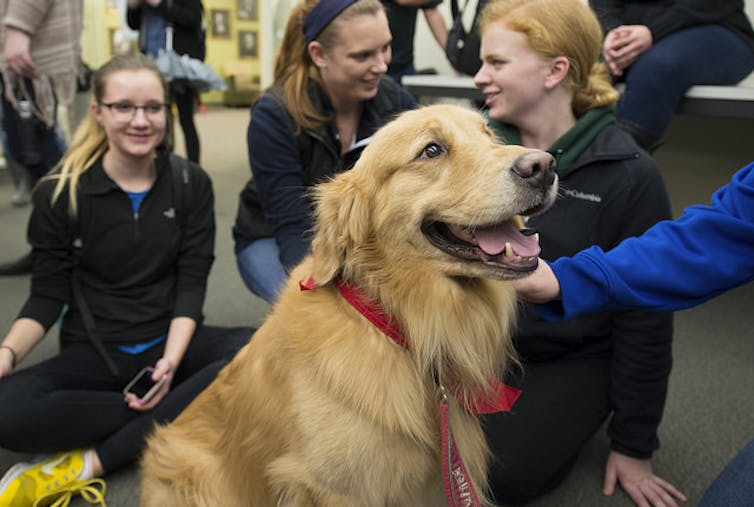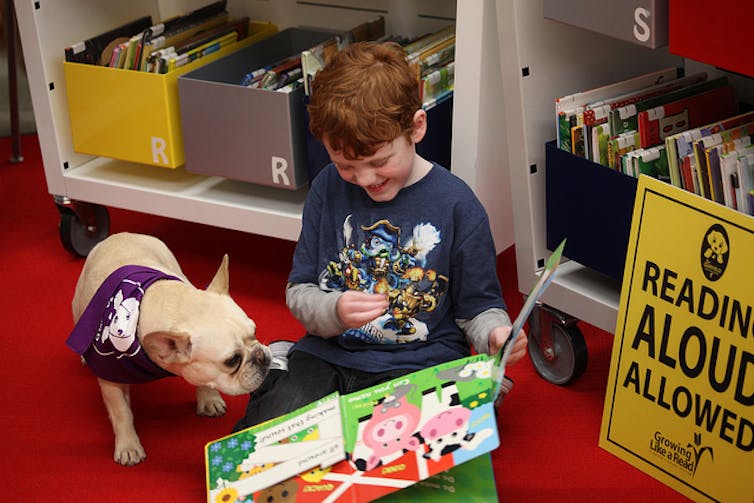In the wake of the schools shootings in Florida, therapy dogs have been used as a way to provide comfort and support for students returning to school. Research has shown therapy dogs can reduce stress and provide a sense of connection in difficult situations.
Given the impact therapy dogs can have on student well-being, schools and universities are increasingly adopting therapy dog programs as an inexpensive way of providing social and emotional support for students.
What are therapy dogs?
It’s important to note therapy dogs are not service dogs. A service dog is an assistance dog that focuses on its owner to the exclusion of all else. Service dogs are trained to provide specific support for individuals with disabilities such as visual or hearing difficulties, seizure disorders, mobility challenges, and/or diabetes.
The role of therapy dogs is to react and respond to people and their environment, under the guidance and direction of their owner. For example, an individual might be encouraged to gently pat or talk to a dog to teach sensitive touch and help them be calm.

The human-animal bond can impact people and animals in positive ways. Ohio University Libraries/Flickr, CC BY-NC-ND
Therapy dogs can also be used as part of animal assisted therapy. This aims to improve a person’s social, cognitive and emotional functioning. A health care professional who uses a therapy dog in treatment may be viewed as less threatening, potentially increasing the connection between the client and professional.
There are also animal-assisted activities, which is an umbrella term covering many different ways animals can be used to help humans. One example is to facilitate emotional or physical mental health and wellbeing through pet therapy or the presence of therapy dogs. These activities aren’t necessarily overseen by a professional, nor are they specific psychological interventions.
Research suggests using therapy dogs in response to traumatic events can help reduce symptoms of depression, post traumatic stress disorder and anxiety.
So, what can happen psychologically for people using therapy dogs?
The human-animal bond
The human-animal bond can impact people and animals in positive ways. Research shows therapy dogs can reduce stress physiologically (cortisol levels) and increase attachment responses that trigger oxytocin – a hormone that increases trust in humans.
Dogs also react positively to animal-assisted activities. In response to the human-animal bond, dogs produce oxytocin and decrease their cortisol levels when connecting with their owner. Often dogs feel the same when engaging in animal assisted activities as if they were at home, depending on the environmental context.
Benefits of therapy dogs
Animal assisted therapy can:
-
teach empathy and appropriate interpersonal skills
-
help individuals develop social skills
-
be soothing and the presence of animals can more quickly build rapport between the professional and client, and
-
improve individual’s skills to pick up social cues imperative to human relationships. Professionals can process that information and use it to help clients see how their behaviour affects others.
More recently, therapy dogs are being used as a form of engagement with students at school and university.
Benefits of therapy dogs at school

Research shows therapy dogs can be used to assist with social/emotional learning needs. Pioneer Library System/Flickr, CC BY-NC-ND
A recent report highlighted children working with therapy dogs experienced increased motivation for learning, resulting in improved outcomes.
Therapy dogs are being used to support children with social and emotional learning needs, which in turn can assist with literacy development.
Research into the effects of therapy dogs in schools is showing a range of benefits including:
-
decreases in learner anxiety behaviours resulting in improved learning outcomes, such as increases in reading and writing levels
-
positive changes towards learning and improved motivation, and
-
enhanced relationships with peers and teachers due to experiencing trust and unconditional love from a therapy dog. This in turn helps students learn how to express their feelings and enter into more trusting relationships.
Despite these known benefits, many schools choose not to have therapy dog programs due to perceived risks. These range from concerns about sanitation issues to the suitability of dog temperament when working with children. But therapy dogs and owners are carefully selected and put through a strict testing regime prior to acceptance into any program.
The main reason for the lack of take up has been linked to the limited research into the benefits of therapy dogs in schools.
Benefits of therapy dogs at university
Researchers have found university students reported significantly less stress and anxiety, and increased happiness and energy, immediately following spending time in a drop-in session with a dog present, when compared to a control group of students who didn’t spend any time with a therapy dog.
Generally, therapy dog programs rely on volunteer organisations. One example is Story Dogs, who currently have 323 volunteer dog teams in 185 schools across NSW, Queensland, Victoria, Tasmania, SA, WA, and ACT. In total, they help 1,615 children each week.
![]() Research into these programs is needed to help further understand the impacts of therapy dogs, especially on student learning and academic outcomes. Lack of funding is setting this research back. University partnerships are one solution to address this.
Research into these programs is needed to help further understand the impacts of therapy dogs, especially on student learning and academic outcomes. Lack of funding is setting this research back. University partnerships are one solution to address this.
–
Christine Grove, Educational Psychologist and Lecturer, Monash University and Linda Henderson, Senior Lecturer, Monash University. This article was originally published on The Conversation. Read the original article.
[Image Credit: Kaitlyn Sullivan]
















Leave a Comment
Your email address will not be published. Required fields are marked with *